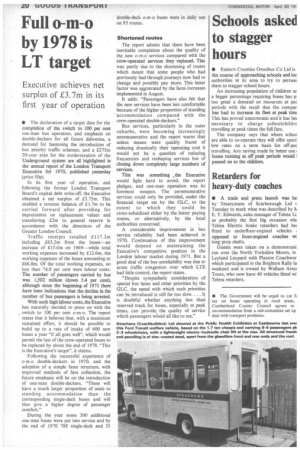Full o-m-o by 1978 is LT target
Page 22

If you've noticed an error in this article please click here to report it so we can fix it.
Executive achieves net surplus of £3.7m in its first year of operation
• The declaration of a target date for the completion of the switch to 100 per cent one-man bus operation, and emphasis on double-deckers for all future deliveries, a demand for hastening the introduction of bus priority traffic schemes, and a £275m 20-year plan for the modernization of the Underground system are all highlighted in the annual report of the London Transport Executive fot 1970, published yesterday (price 50p).
In its first year of operation, and following the former London Transport Board's capital debt write-off, the Executive obtained a net surplus of £3.75m. This enabled a revenue balance of E1.7m to be carried forward after providing for depreciation on replacement values and transferring ilm to general reserve in accordance with the directions of the Greater London Council.
Traffic receipts totalled -£117.3m including £63.2m from the buses—an increase of £15.6m on 1969—while total working expenses increased by £12.6m, the working expenses of the buses amounting to £66.8m. Of the total working expenses, no less than 74.8 per cent were labour costs. The number of passengers carried by bus was 1,502 million (down 5.4 per cent), although since the beginning of 1971 there have been indications that the decline in the number of bus passengers is being arrested.
With such high labour costs, the Executive has naturally decided to press on with the switch to 100 per cent o-m-o. The report states that it believes that, with a maximum sustained effort, it should be possible to build up to a rate of intake of 600 new buses a year "if all goes well", which would permit the last of the crew-operated buses to be replaced by about the end of 1978. "This is the Executive's target", it claims.
Following the successful experience of o-m-o double-deckers in 1970, and the adoption of a simple fares structure, with improved methods of fare collection, the future emphasis will be on the introduction of one-man double-deckers. "These will have a much larger proportion of seats to standing accommodation than the corresponding single-deck buses and will thus give a higher degree of passenger comfort."
During the year some 300 additional one-man buses were put into service and by the end of 1970 788 single-deck and 35 double-deck o-m-o buses were in daily use on 95 routes.
Shortened routes The report admits that there have been inevitable complaints about the quality of the new o-m-o services compared with the crew-operated services they replaced. This was partly due to the shortening of routes which meant that some people who had previously had through journeys now had to change and possibly pay more. This latter factor was aggravated by the fares increases implemented in August.
It adds: "Passengers have also felt that the new services have been less comfortable because of the higher proportion of standing accommodation compared with the crew-operated double-deckers."
Bus services, particularly in the outer suburbs, were becoming increasingly unremunerative and the report warns that unless means were quickly found of reducing drastically their operating cost it would not be a question of reducing frequencies and reshaping services but of closing down completely large numbers of services.
This was something _the Executive would fight hard to avoid, the report pledges, and one-man operation was its foremost weapon. The unremunerative services could only be provided, under the financial target set by the GLC, to the extent to which they could be cross-subsidized either by the better paying routes, or alternatively, by the local authorities concerned.
A considerable improvement in bus service reliability had been achieved in 1970. Continuance of this improvement would depend on maintaining the Executive's competitive position in the London labour market during 1971. But a good deal of the bus unreliability was due to acute traffic congestion over which LTE had little control, the report states.
"Despite sympathetic consideration of special bus lanes and other priorities by the GLC, the speed with which such priorities can be introduced is still far too slow. . .. It is doubtful whether anything less than reserved track for buses, especially at peak times, can provide the quality of service which passengers would all like to see."




























































































